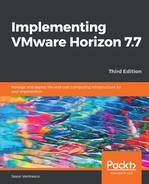Desktop optimization benefits one infrastructure component more than any other: storage. Until all flash storage arrays achieve price parity with the traditional spinning disk arrays many of us use today, reducing the per-desktop Input/Output Operations Per Second (IOPS) required will continue to be an important part of any Horizon deployment.
The following graph shows the reduction in IOPS that occurred after performing the optimization techniques described later in this chapter. This measurement was observed while testing the desktop using a user workload simulator:

The optimized desktop generated 15 percent fewer IOPS during the user workload simulation. By itself, that may not seem like a significant reduction, but when multiplied by hundreds or thousands of desktops, the savings become more significant.
